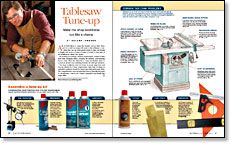How to Tune Up Your Table Saw
Make the shop workhorse run like a champ
Synopsis: Tablesaws are so sturdy and powerful that they seem not to need any special attention. But like any complex tool, they develop flaws that can erode performance. Keeping your saw clean, lubricated, and properly adjusted will make it safer, more accurate, and easier to use. If your tablesaw suffers from blade wobble, stiff adjustments, inaccurate cutting angles, jerky starts and loss of power, or if you simply want to head off those problems before they ever happen, follow Roland Johnson through this thorough tablesaw tune-up.
Ask woodworkers to name the busiest tool in their shop, and it’s a safe bet many will point to the tablesaw. A machine that can rip sheet goods down to size, cut boards to length, and create a variety of joints is bound to carry part of the workload in almost any project.
Yet in many woodshops, tablesaw maintenance consists of little more than changing blades, cleaning the tabletop, and squaring fences. Only when the blade-tilt or -raise mechanism starts to screech in protest does anything beneath the table get attention.
Our shop workhorse deserves better. A yearly inspection and tune-up should be a basic requirement; saws kept in damp or unheated conditions should be cleaned and lubricated more often. The comprehensive tune-up presented here is basically the same for all tablesaws. Check your owner’s manual for any details that might differ.
On most cabinet saws, removing the tabletop exposes the inner workings and makes a tune-up much easier.
First, unplug the saw, then remove the throat plate and the blade to avoid damaging the blade or yourself. Measure and record the distance from the left-hand miter slot to the blade. You’ll need this measurement to reassemble the saw accurately.
Now undo the bolts that hold the top to the base and remove any extension tables or fence rails. If a strong friend is helping, you might be able to lift the top with all of its accessories, but it will be awkward and heavy.
The inside of a tablesaw is a grimy, dusty place. Without regular cleaning, wood resin and sawdust can cake up and stiffen a saw’s inner workings, especially the blade-height and -angle adjustments.
Use a shop vacuum and compressed air to get rid of the sawdust, then attack the gears and pivoting parts with grease-cutting solvent and a wire brush. I like to use LPS-brand solvents because they cut grease aggressively and don’t leave an oily residue (available at National Supply Source, www.nolansupply. com; call LPS at 800-241-8334 for retailers near you). Aerosol brake cleaner or carburetor cleaner also will work. Although the bearings in a tablesaw are sealed, avoid getting solvent directly on them. Some of these products also can damage paint, so buy and apply them carefully. In any case, buy a high-quality solvent that will evaporate quickly.
Remember, when using volatile solvents, make sure you have an adequate fresh-air supply and wear a vapor mask.
Finish the cleaning process with a compressed-air blowdown to speed drying and remove crud softened by the solvent. The overall goal in all of these steps is to clear away as much dust and pitch as possible, leaving clean, dry surfaces for an effective lube job. Be sure the solvent is completely cleaned out or dry before applying new lube to the contact surfaces.
Before moving on, give some attention to the motor. Blow compressed air through the housing until the exhaust air is clean.
from Fine Woodworking #179
For the full article, download the PDF below:
Fine Woodworking Recommended Products

Stanley Powerlock 16-ft. tape measure

Ridgid EB4424 Oscillating Spindle/Belt Sander

Festool Cleantec CT 26 E HEPA Dust Extractor























Log in or create an account to post a comment.
Sign up Log in